Picture your living room transformed into a lush urban oasis, where carefully placed greenery creates an instant sense of calm and connection to nature. You’ll discover how strategic placement of plants, from towering floor specimens to delicate trailing vines, can dramatically enhance your space without overwhelming it. Whether you’re working with a compact apartment or spacious living area, these professional design techniques will help you create the perfect balance of style and serenity in your home.
Contents
- 1 Create a Vertical Garden Wall Display
- 2 Style Your Window Sills With Trailing Plants
- 3 Mix Plant Heights for Visual Interest
- 4 Design a Statement Corner With Large Floor Plants
- 5 Arrange Botanical Shelving Units
- 6 Incorporate Hanging Planters for Dimension
- 7 Group Plants by Color and Texture
- 8 Set Up a Coffee Table Plant Display
- 9 Build a Room Divider With Plants
- 10 Layer Plants Around Seating Areas
Create a Vertical Garden Wall Display
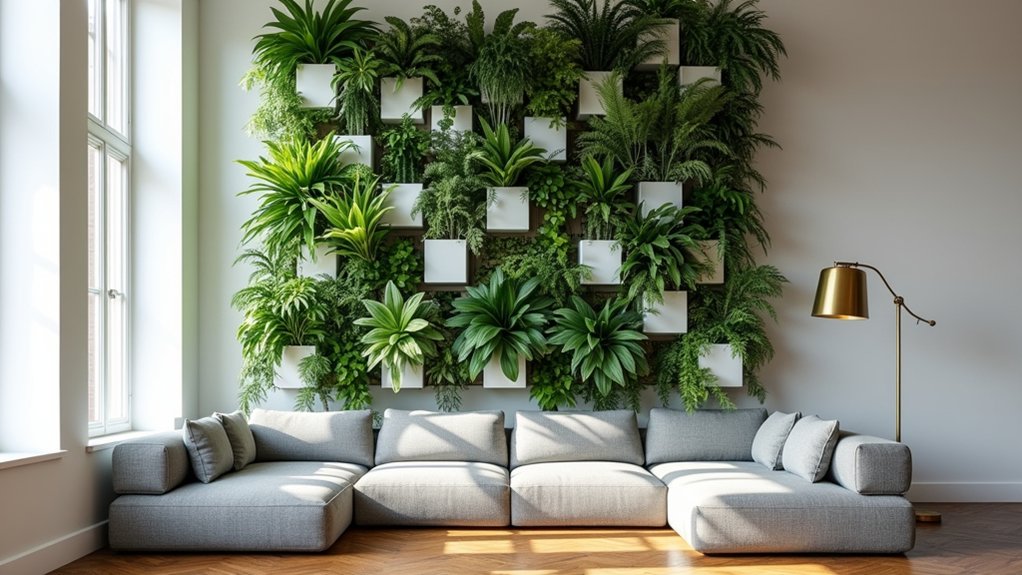
A vertical garden wall display transforms blank indoor walls into lush, living tapestries of greenery by mounting plants in a structured, upward arrangement. This space-saving design typically features a mix of trailing, climbing, and compact plants arranged in specialized wall-mounted planters, pocket systems, or modular panels.
The display can range from simple floating shelves with potted plants to elaborate hydroponic systems, creating a stunning focal point while maximizing available growing space in smaller rooms.
Growing Conditions:
- Light: Moderate to bright indirect light, avoiding harsh direct sunlight that can stress plants
- Humidity: 40-60% relative humidity, may require supplemental misting
- Temperature: 65-80°F (18-27°C)
- Growing Medium: Lightweight, well-draining potting mix for soil-based systems
- Mounting: Secure attachment to load-bearing walls capable of supporting wet soil weight
- Air Circulation: Good airflow to prevent moisture-related issues
Regular maintenance is crucial for a thriving vertical garden wall. Inspect the mounting system weekly for stability and signs of water damage.
Rotate plants periodically to ensure even growth, and trim away dead or yellowing foliage promptly to maintain appearance and prevent disease spread. Monitor irrigation systems carefully, adjusting water flow to prevent over-saturation of plants at the bottom of the display.
Dust leaves monthly with a damp cloth to maintain photosynthesis efficiency and aesthetic appeal.
Style Your Window Sills With Trailing Plants
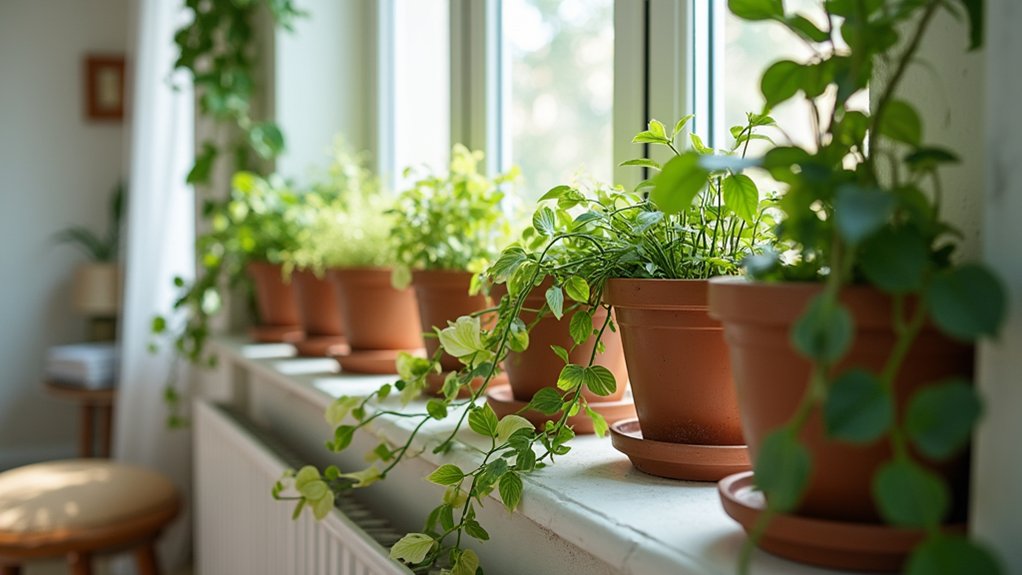
Window sills adorned with trailing plants create a living curtain of cascading foliage that softens architectural lines and brings natural movement to indoor spaces. Popular choices like Pothos, String of Pearls, and English Ivy spill gracefully over the edges, creating dramatic vertical interest while maximizing limited horizontal space.
These trailing varieties not only frame the window beautifully but also thrive in the natural light conditions typically found at window locations.
- Light: Bright, indirect sunlight; morning sun is ideal; protect from harsh afternoon rays
- Water: Allow top inch of soil to dry between waterings; reduce frequency in winter
- Soil: Well-draining potting mix with added perlite
- Humidity: Moderate to high; mist leaves regularly in dry conditions
- Temperature: 65-80°F (18-27°C)
- Container: Pots with drainage holes; hanging baskets or window boxes
- Fertilizer: Balanced liquid fertilizer monthly during growing season
Regular pruning encourages fuller growth and prevents plants from becoming leggy, while periodic rotation ensures even growth patterns as plants naturally reach toward light sources.
Remove yellowed or dead foliage promptly to maintain appearance and plant health, and dust leaves monthly to maintain photosynthesis efficiency. Support longer vines with gentle ties or decorative hooks if desired, and pinch back growing tips to promote branching and create a more abundant display.
Mix Plant Heights for Visual Interest
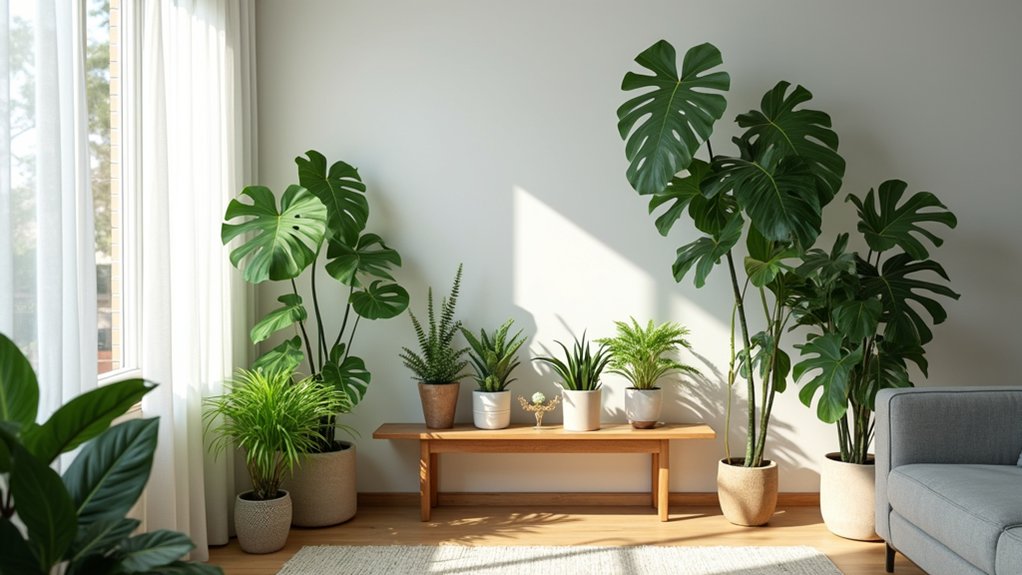
Creating visual interest through varied plant heights transforms indoor spaces into dynamic, multi-layered displays. Combining tall floor plants, medium-sized tabletop varieties, and trailing specimens adds depth and dimension to any room. This design approach utilizes plants of different growth habits, placing taller specimens like fiddle leaf figs or palm trees as backdrop anchors, medium-height plants like peace lilies or snake plants at mid-level, and cascading varieties like pothos or string of pearls at lower levels or in hanging planters.
Growing Conditions for Mixed-Height Displays:
- Position taller plants against walls or in corners to avoid blocking natural light to shorter specimens.
- Ensure each plant receives appropriate light based on its individual needs.
- Group plants with similar water requirements together for efficient maintenance.
- Use containers with proper drainage for all height levels.
- Maintain adequate spacing between plants to prevent overcrowding.
Successful maintenance of mixed-height displays requires regular rotation of plants to ensure even growth and prevent stretching toward light sources.
Monitor each plant’s growth rate and adjust positioning as needed, particularly for faster-growing specimens that may overtake neighboring plants. Prune and shape plants periodically to maintain desired heights and prevent overcrowding, while regularly cleaning leaves at all levels to maximize light absorption and maintain aesthetic appeal.
Design a Statement Corner With Large Floor Plants
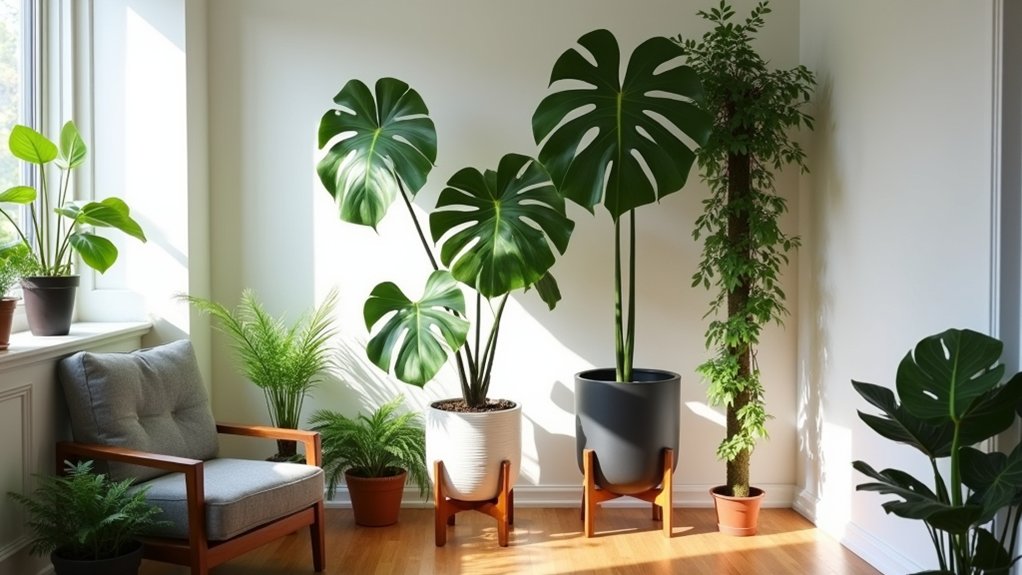
Creating a statement corner with large floor plants transforms an empty space into a dramatic focal point using towering specimens like Fiddle Leaf Figs, Bird of Paradise, or Monstera Deliciosa.
These architectural plants, when grouped strategically in varying heights and textures, create a lush, jungle-like atmosphere that draws the eye and adds vertical interest to any room. The arrangement can be enhanced with decorative pots, plant stands at different levels, and complementary smaller plants to create a layered, professional look.
Growing Conditions:
- Bright, indirect light with some morning sun exposure
- Temperature between 65-80°F (18-27°C)
- Moderate to high humidity (40-60%)
- Well-draining potting mix rich in organic matter
- Large containers with drainage holes
- Space between plants for adequate air circulation
- Monthly rotation to ensure even growth on all sides
Regular maintenance of statement corner plants requires careful attention to prevent competition between specimens while maintaining their dramatic impact.
Dust large leaves weekly with a damp cloth to maximize light absorption and photosynthesis. Prune strategically to maintain desired shapes and remove any yellowing or damaged foliage promptly.
Inspect plants monthly for signs of pests or disease, particularly in areas where foliage overlaps. As plants grow, adjust their positions and heights to maintain visual balance and prevent overcrowding.
Arrange Botanical Shelving Units
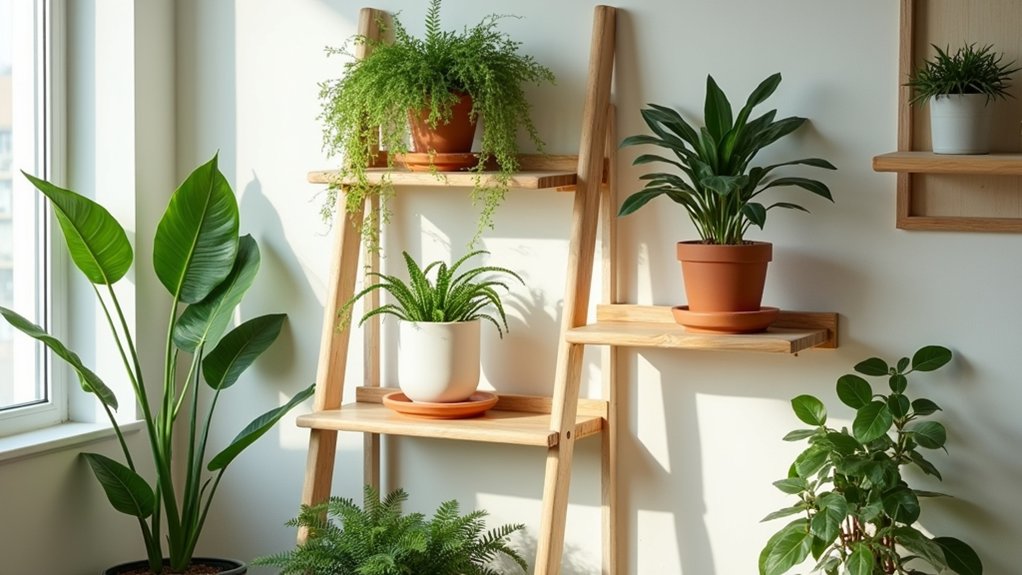
Botanical shelving units transform ordinary shelves into stunning living displays by artfully arranging plants at varying heights and depths. These decorative arrangements typically feature a mix of trailing plants cascading down shelf edges, upright specimens creating vertical interest, and compact varieties filling middle spaces.
The shelves themselves can be floating, ladder-style, or traditional bookcase designs, often incorporating materials like wood, metal, or glass to complement the natural elements of the plants.
- Light: Position shelving unit near east or north-facing windows; ensure all plants receive adequate light based on individual needs
- Space: Allow 6-12 inches between plants for proper air circulation
- Structure: Use sturdy shelves rated for weight of pots, soil, and water
- Drainage: Place waterproof trays under each plant to protect shelving
- Height placement: Position sun-loving plants on upper shelves, shade-tolerant varieties below
Regular maintenance of botanical shelving units requires strategic rotating of plants to ensure even growth and prevent leaning toward light sources.
Dust leaves weekly with a soft cloth to maintain photosynthesis efficiency and aesthetic appeal. Inspect plants regularly for signs of pests, which can quickly spread in close-quarter arrangements.
Trim away dead or yellowing foliage promptly to maintain the display’s professional appearance and prevent disease spread among neighboring plants.
Incorporate Hanging Planters for Dimension
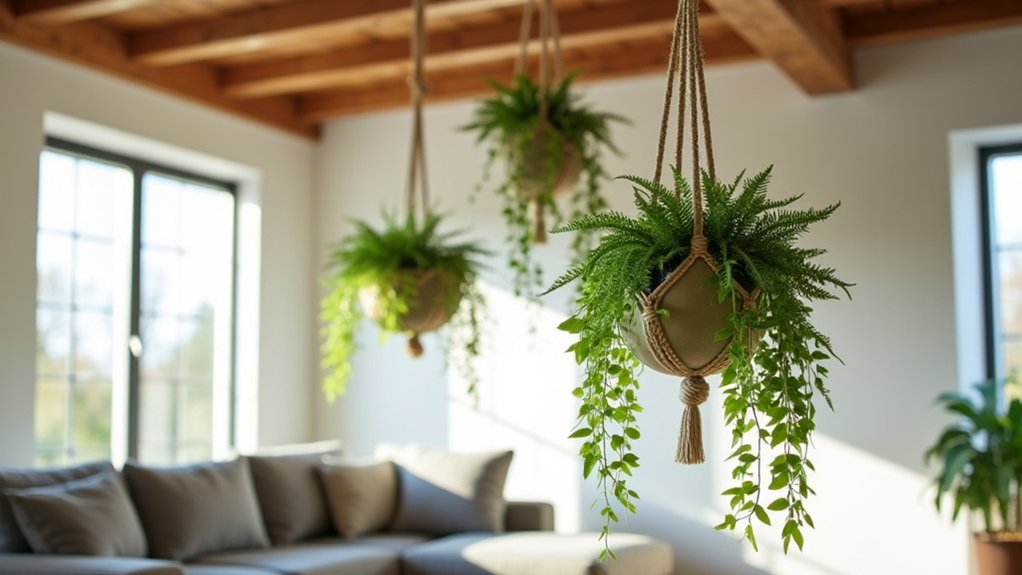
Hanging planters add vertical interest and create dynamic layers in indoor spaces, transforming unused overhead areas into stunning green displays. These suspended gardens can feature trailing plants cascading from ceiling hooks, wall-mounted brackets, or decorative macramé holders, creating a lush, three-dimensional effect that draws the eye upward.
The versatility of hanging planters allows for creative placement in corners, windows, or along beams, making them particularly effective in smaller spaces where floor space is limited.
Growing Conditions:
- Position 6-12 inches below ceiling height for easy maintenance
- Choose locations with adequate airflow to prevent moisture buildup
- Install in spots receiving indirect light, avoiding direct afternoon sun
- Select lightweight containers with proper drainage holes
- Use well-draining potting mix specifically formulated for container plants
- Maintain consistent moisture levels without overwatering
Regular maintenance of hanging planters involves checking support systems monthly for security and wear, rotating containers quarterly for even growth, and pruning trailing stems as needed to maintain desired length and fullness.
Dust leaves gently with a damp cloth to maintain photosynthesis efficiency, and inspect plants weekly for signs of pest infestation or disease, which can spread quickly in elevated environments.
Consider installing a pulley system or keeping a small stepladder nearby for easier access to higher-mounted planters during maintenance routines.
Group Plants by Color and Texture
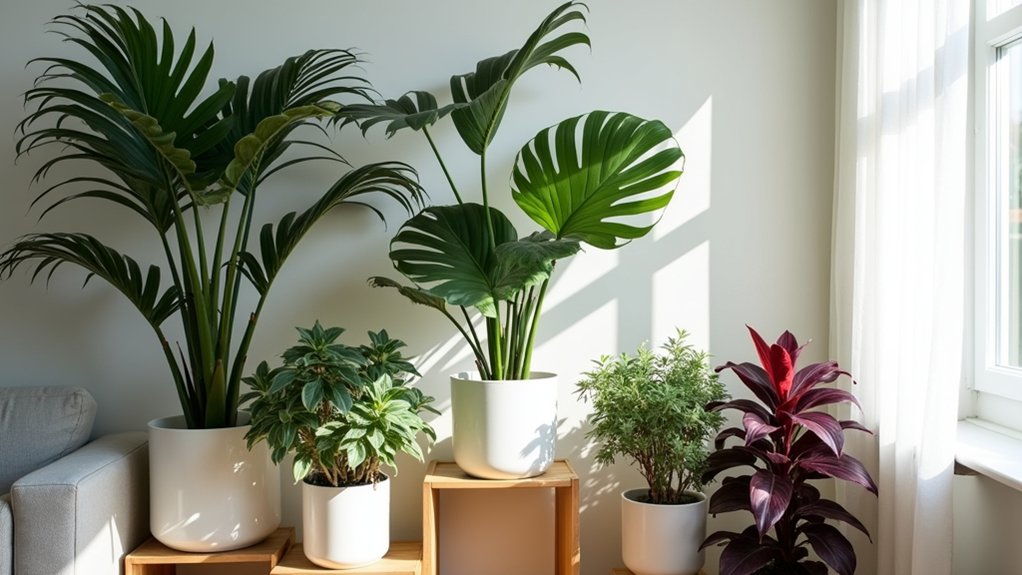
Grouping plants by color and texture creates visually striking indoor displays that maximize aesthetic impact. This design approach involves arranging plants with similar leaf colors, patterns, or textural elements together, such as clustering silver-toned succulents with dusty miller, or pairing smooth-leafed plants like peace lilies with textured ferns. Creating these coordinated groupings adds depth and interest to your space while maintaining a cohesive look.
- Light requirements: Ensure all grouped plants have similar light needs; place high-light plants together in bright spots, shade-lovers in dimmer areas.
- Water needs: Cluster plants with comparable watering schedules to simplify care routine.
- Spacing: Allow 2-3 inches between pots for proper air circulation.
- Container selection: Use pots with similar styles or colors to enhance the grouping’s visual harmony.
- Temperature: Group plants with matching temperature preferences, typically 65-75°F (18-24°C).
- Humidity zones: Combine plants that thrive in similar humidity levels.
To maintain attractive plant groupings, rotate containers regularly to ensure even growth on all sides and prevent plants from stretching toward light sources.
Monitor the size of growing plants and rearrange groups as needed to accommodate larger specimens. Remove any yellowing or dead foliage promptly to maintain the aesthetic appeal, and regularly assess whether plants are competing for resources within their groupings, adjusting positions accordingly.
Set Up a Coffee Table Plant Display
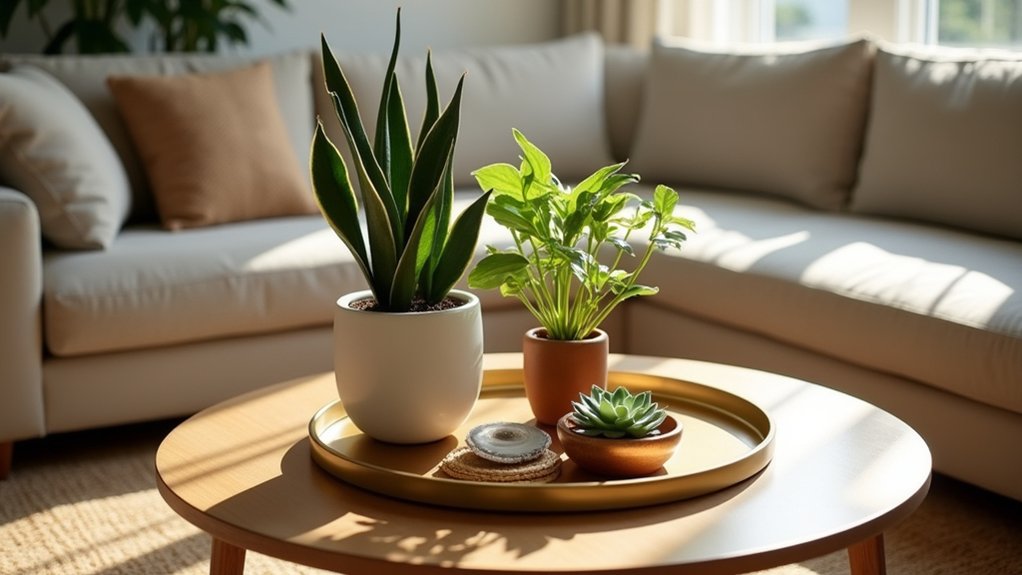
A coffee table plant display creates an eye-catching focal point in your living space by combining different plant varieties, heights, and textures in an artful arrangement. Select 3-5 plants of varying sizes, incorporating elements like succulents, trailing plants, and upright specimens, then group them on decorative trays, vintage books, or natural wood platforms.
Consider using plants with complementary colors and adding decorative elements like crystals, small sculptures, or ceramic vessels to enhance visual interest.
Growing Conditions:
- Choose plants with similar light requirements, ideally suited for moderate to bright indirect light
- Select drought-tolerant varieties that can withstand occasional neglect
- Use well-draining potting soil appropriate for each plant type
- Maintain indoor temperatures between 65-80°F (18-27°C)
- Group plants with similar humidity preferences
- Ensure containers have drainage holes or use cache pots
Regular grooming and rotation ensure a polished coffee table display throughout the year. Remove dead leaves promptly, dust plant foliage weekly with a soft brush or damp cloth, and rotate plants quarterly to promote even growth.
Monitor the arrangement’s overall appearance, replacing struggling plants or refreshing the design seasonally to maintain visual appeal. Consider incorporating air-purifying plants like snake plants or peace lilies to improve indoor air quality while maintaining aesthetic appeal.
Build a Room Divider With Plants
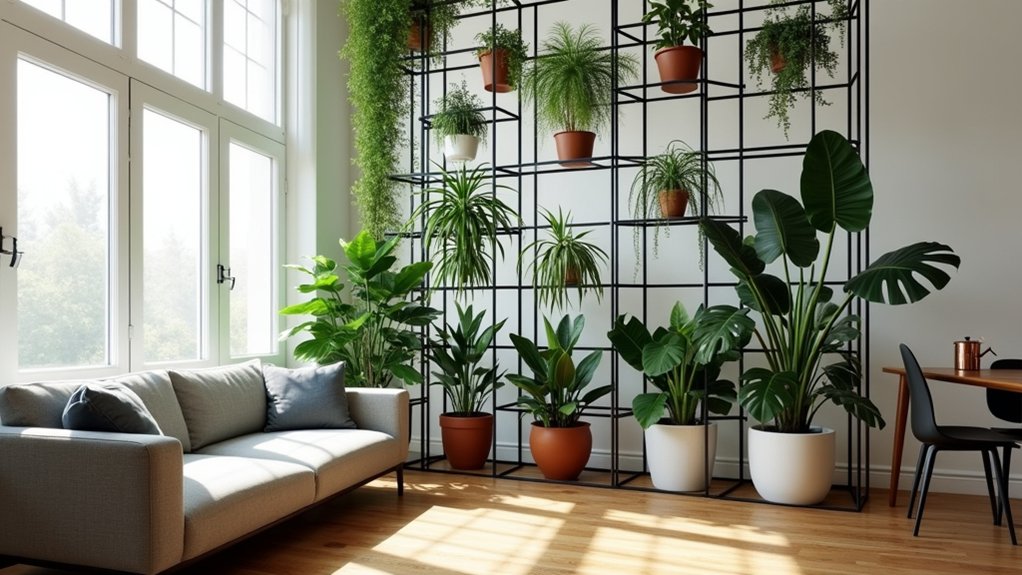
Creating a plant-based room divider offers a natural and aesthetically pleasing way to separate spaces while maintaining an open, airy feel. This living partition can be constructed using various methods, such as mounting shelves between floor-to-ceiling poles, utilizing macramé hangers, or installing a grid-style framework.
Plants of different sizes, textures, and trailing habits can be arranged at varying heights to create visual interest and maximize the screening effect while allowing light to filter through.
- Light requirements: Bright, indirect light is ideal; avoid placing divider in dark corners or direct sunlight
- Water needs: Varies by plant selection; generally water when top 1-2 inches of soil feels dry
- Temperature: Maintain consistent room temperature between 65-80°F (18-27°C)
- Humidity: 40-60% humidity level, use a humidifier if needed
- Soil type: Well-draining potting mix appropriate for chosen plant varieties
- Support structure: Must be sturdy enough to hold pot weights and allow for plant growth
Regular maintenance of a plant room divider includes rotating pots quarterly for even growth, pruning wayward stems, and dusting leaves monthly.
Inspect plants weekly for signs of pests or disease, especially where foliage touches neighboring plants. Consider installing a drip tray system or using self-watering pots to manage moisture levels effectively, and periodically check that support structures remain secure as plants grow and add weight to the system.
Layer Plants Around Seating Areas
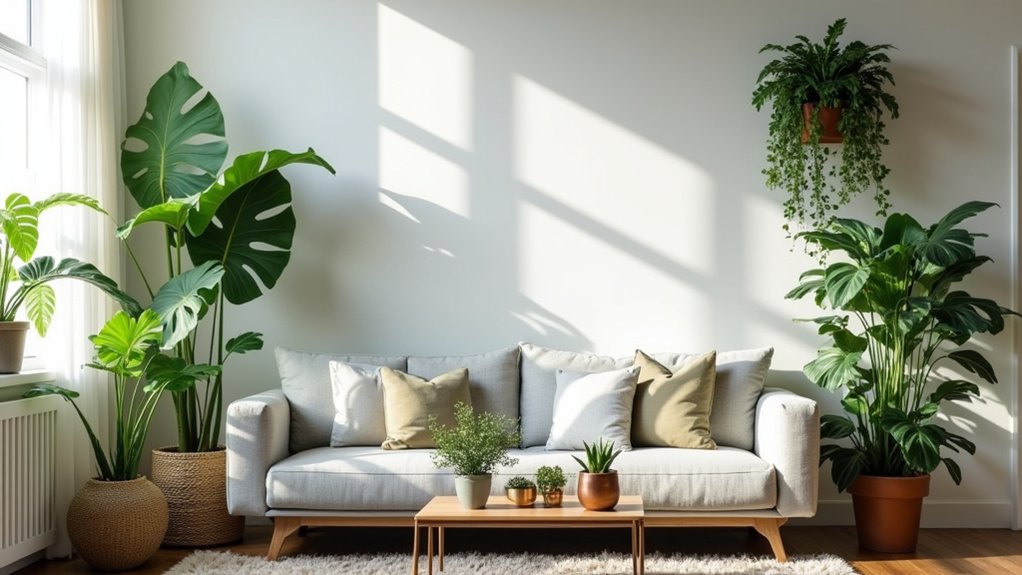
Layering plants around seating areas creates depth, visual interest, and a cozy atmosphere in living spaces. This decorative approach involves placing plants of varying heights, textures, and sizes strategically around chairs, sofas, and lounging areas.
Typically, taller plants like fiddle leaf figs or palm trees are positioned behind furniture, medium-sized plants like snake plants or peace lilies are placed alongside seating, and smaller plants or trailing varieties occupy coffee tables or side tables, creating a natural, cascading effect.
Plant Selection and Placement Requirements:
- Choose plants with similar light requirements for each seating area
- Ensure adequate spacing between plants to prevent overcrowding
- Position taller plants at least 2-3 feet behind furniture
- Select a mix of upright and trailing plants for dimensional variety
- Group plants with similar watering needs together
- Consider plants’ mature sizes when planning arrangement
- Account for air circulation between furniture and plants
Maintaining a layered plant arrangement requires regular assessment and adjustment.
Rotate plants quarterly to ensure even growth and prevent them from becoming leggy or reaching toward light sources. Periodically rearrange plants to accommodate seasonal growth patterns and replace any specimens that outgrow their designated spaces.
Dust leaves weekly to maintain aesthetic appeal and healthy photosynthesis, and adjust groupings as needed when entertaining to maintain clear sightlines and comfortable conversation areas.
